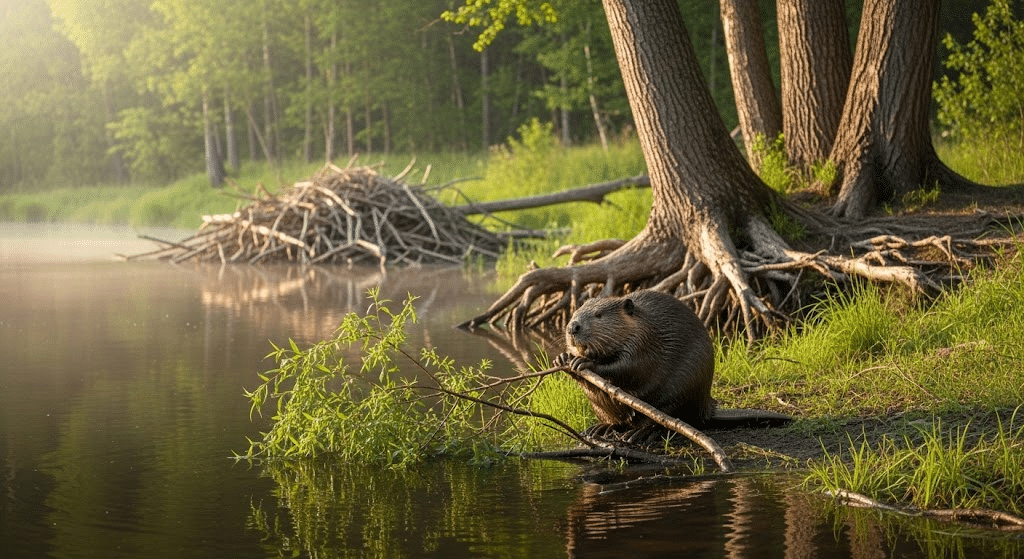Ever watched a beaver work and wondered how these furry engineers fuel their construction projects? Most people think they know the answer, but there’s more to beaver dining than meets the eye.
Understanding what do beavers eat reveals amazing details about their survival skills and habitat choices. These water-loving mammals have specific food preferences that change with seasons, and their diet directly impacts entire ecosystems.
This blog will show you precisely what beavers munch on throughout the year, from their favorite tree bark to shocking seasonal treats.
Get ready to learn why beaver food choices matter more than you might think.
All About Beavers and What They Eat

Beavers follow a completely plant-based diet in their natural habitat.
They never hunt other animals or eat meat, making them true herbivores. This might surprise people who see them gnawing on trees all day long.
Many folks ask, “do beavers eat wood?” The answer is more complex than a simple yes or no. While beavers chew through wood to build their dams and lodges, they don’t actually consume the woody parts. Instead, they strip away the outer bark to reach the soft, nutritious inner layer called cambium.
What does a beaver eat actually depends largely on the season and what plants grow near their water homes.
During spring and summer, they feast on soft water plants, grasses, and fresh shoots. When winter arrives, they rely heavily on stored branches and the inner bark of trees they’ve collected.
Plant-Based Diet Basics
Beavers have evolved special digestive systems to break down tough plant materials. Their stomachs contain helpful bacteria that help process cellulose from plants.
This allows them to get nutrients from materials that would be impossible for humans to digest.
Their large front teeth grow continuously throughout their lives. This constant growth is necessary because gnawing on hard bark wears them down quickly. The orange color of their teeth comes from iron, which makes them extra strong for their plant-eating lifestyle.
Seasonal Food Preferences
Spring brings fresh growth, and beavers take full advantage. They love tender water lily shoots, cattail roots, and young tree branches. Summer offers the richest variety of food options, including pond weeds, grasses, and herbaceous plants.
Fall becomes preparation time. Beavers work hard to collect and store branches underwater near their lodges.
These food caches will sustain them through the harsh winter months when fresh plants become scarce. Winter forces them to rely almost entirely on bark and stored plant materials.
Beaver’s Favorite Trees

Beavers are picky shoppers when it comes to trees. They don’t just chew on any wood they find. These smart animals know exactly which trees offer the best nutrition and taste.
Aspen trees top their favorite list. The bark tastes sweet and provides excellent nutrition. Beavers can smell aspen from far away and will travel considerable distances to find it. Willow comes in second place, offering tender bark that’s easy to digest.
Other preferred tree choices include:
- Poplar trees – soft bark with high water content
- Birch – provides good nutrition, especially in winter
- Alder – grows near water, making it convenient to harvest
- Cottonwood – large trees that offer plenty of food
- Maple – occasional treat when other options are limited
Beavers avoid pine, oak, and other hardwood trees because their bark contains compounds that taste bitter and are harder to digest.
Soft Vegetation in Beaver Diets
Trees aren’t the whole story when people ask what do beavers eat. These water-loving mammals actually prefer soft, juicy plants when they are available. Think of trees as their backup meal, not their first choice.
During warm months, beavers become underwater gardeners. They munch on water lilies, their roots, and stems with obvious delight. Cattails make another favorite snack – beavers eat both the shoots and the starchy roots that grow beneath the water.
Pond weeds, grasses, and ferns round out their green menu. They also enjoy clover, dandelions, and other herbs that grow near the water’s edge.
Many people wonder, do beavers eat wood, but the truth is they much prefer these tender plants. What does a beaver eat changes dramatically between seasons. Summer brings an abundance of soft vegetation, while winter forces them back to bark and stored branches.
Fresh plants provide more nutrients and require less energy to digest than tough tree bark.
Beaver Feeding Habits and Their Ecological Impact
The answer to the question, what do beavers eat, is simple, but their feeding habits have a major impact on the landscape. Their dining habits create ripple effects that benefit countless other species.
When beavers chomp through trees and build dams, they’re accidentally becoming nature’s top ecosystem engineers.
Their feeding schedule follows a predictable pattern. Beavers are most active during dawn and dusk, spending up to six hours each night foraging for food.
They can consume up to 20% of their body weight daily, which means a 60-pound beaver needs about 12 pounds of plant material every day.
How Beaver Feeding Benefits the Environment:
- Creates wetland habitats when they dam streams for food access
- Provides homes for fish, frogs, birds, and insects in newly formed ponds
- Increases plant diversity as different species grow in wet conditions
- Prevents flooding by slowing water flow downstream
- Stores carbon in wetland soils and vegetation
- Filters water naturally through their pond systems
Feeding Behavior Patterns:
- Work in family groups to gather and store food
- Build underwater food caches near their lodges
- Rotate feeding areas to prevent overuse of plant resources
- Share feeding territories peacefully with neighboring beaver families
This natural recycling system shows how one animal’s eating habits can transform entire regions into thriving wildlife communities.
Astonishing Foods in the Beaver’s Diet
Most people think they know what do beavers eat, but these furry engineers have some unexpected items on their menu. Beyond the typical bark and water plants, beavers enjoy foods that might shock you.
- Mushrooms and fungi that grow on rotting logs near their ponds
- Algae scraped directly from rocks and submerged surfaces
- Flower buds from fruit trees that bloom in spring
- Corn and crops from nearby farms during late summer harvests
- Aquatic moss that grows thick on pond bottoms
- Pine needles during extreme winter food shortages, despite preferring other options
- Fruit that falls into the water from overhanging apple or cherry trees
- Seaweed and marine plants when beavers live near coastal areas
- Root vegetables like wild onions and garlic bulbs
Winding It Up
Beavers demonstrate that a plant-based diet can fuel incredible engineering feats.
From aspen bark to underwater mushrooms, these remarkable animals demonstrate the diversity of herbivore diets.
Understanding what do beavers eat helps us appreciate their vital role in creating wetland ecosystems that support countless other species.
Share this article with fellow nature lovers who might be curious about beaver dining habits, and do comment below with the amazing facts that you know about beavers.


















